In a comment on yesterday’s post about how the process of preening “rehooked” the hooks in the feathers of the Rough-legged Hawk and repaired the damage caused by everyday wear and tear “Diana” made the following comment:
- “Ron. I did not know that preening “rehooks” as you describe. Thought it was for “oiling” feathers. Thanks for the info.”
And this was my response to her comment:
- “Diana, preening/grooming has multiple functions and oiling is certainly one of them. This bird did that too but more than anything else he’s re-zipping hooks in this photo.”.
Diana’s comment and those from many others both here and on Facebook who said something similar made me realize that there’s some confusion about the various functions of preening/grooming in birds so I decided to try to put it all into perspective with today’s post. I’ll do it by using some of my photos of two different birds (some of which I included in a similar post many years ago, thus the older styled copyright watermark) and summarizing the various functions of preening. Apologies for not including image techs but I simply ran out of time..
Birds preen to accomplish the following:
- to remove dirt, debris and parasites from their feathers
- to align their feathers in the best possible positions relative to adjacent feathers and their body shape
- to repair damaged feathers by re-hooking the hooks holding their feather barbs together
- to apply oil from the uropygial gland to their feathers as a dressing
In today’s post I’ll concentrate on how birds oil their feathers.
In birds the uropygial gland (preen gland) is located at the base of the tail. Most birds have it though it’s absent in many of the ratites (flightless birds) such as the emu, cassowary, ostrich, bustard and a few others. The gland is most highly developed in aquatic species, especially pelicans, petrels, osprey and oilbird.
The gland has pores similar to nipples that empty the oily secretions to the skin’s surface. Birds preen by rubbing their bill and face over the gland pores and then transferring that oil to their body feathers, legs and feet.
The oil helps to waterproof feathers and apparently functions as a dressing that enhances feather integrity and may even help to preserve the horny structure of the bill and scales of the feet and legs. There is some evidence to indicate that the gland secretion contains a substance that is a precursor to vitamin D, which is then converted to vitamin D by sunlight and absorbed through the skin. Many researchers believe that the gland functions differently in various bird species.
Ok, I’ve been pontificating long enough. Let’s see how they do it.
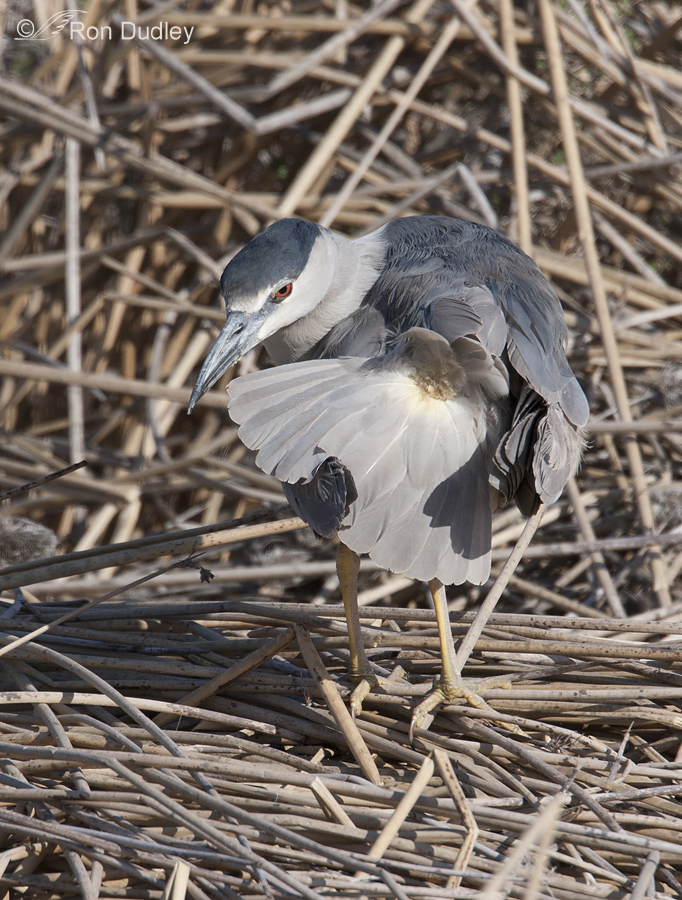
Some years ago I had the unique opportunity of getting a good look at the uropygial gland of an adult Black-crowned Night Heron while it was applying preen oil to its feathers. Here we see the gland beneath the raised feathers at the base of the tail. The feathers are raised temporarily to give the bird access to the gland.
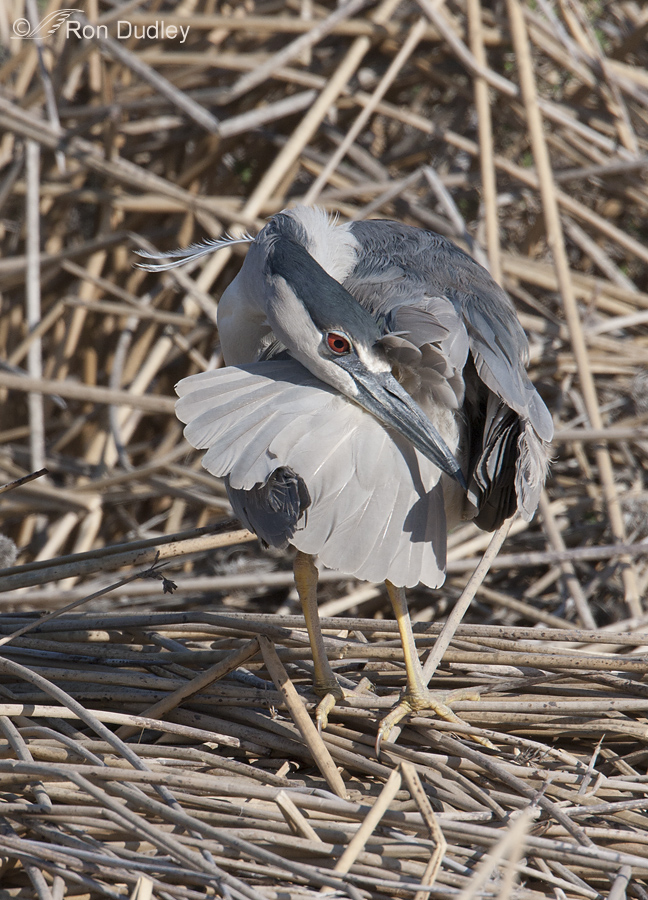
Birds rub their bills over the gland in order to smear the yellow oil over their mandibles and faces and then they transfer the oil to their feathers.
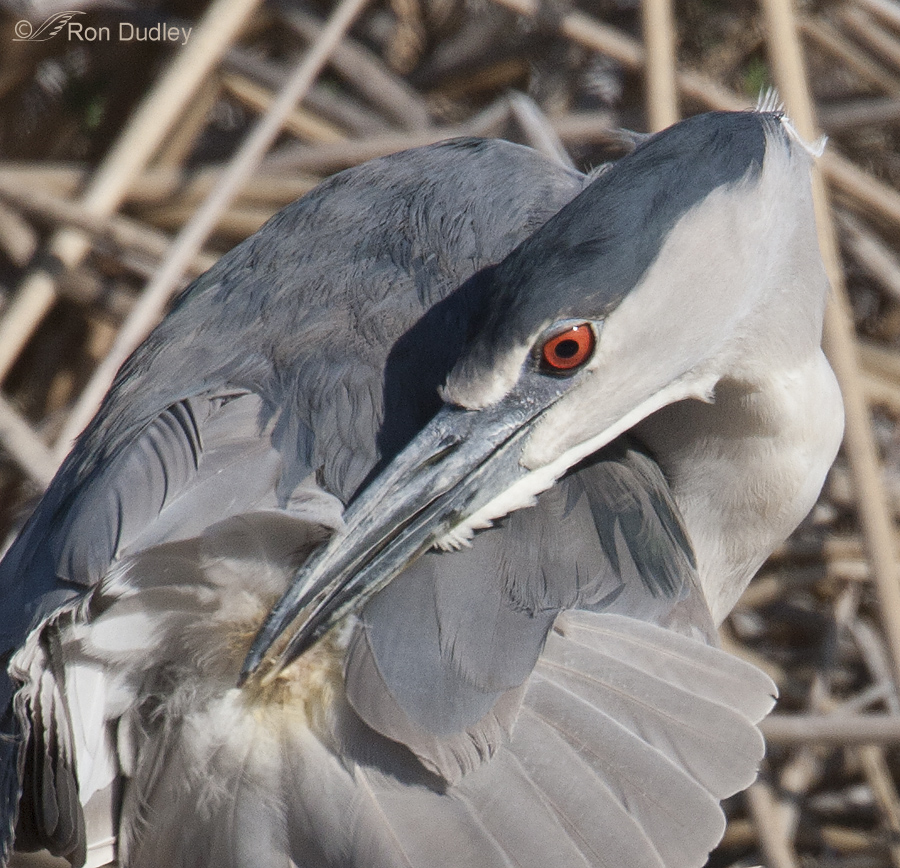
At times the heron actually appeared to be pinching the gland in order to squeeze oil out of it. Usually observers can never see the gland but I happened to be close enough to the heron and at just the right angle to get a good look at it.
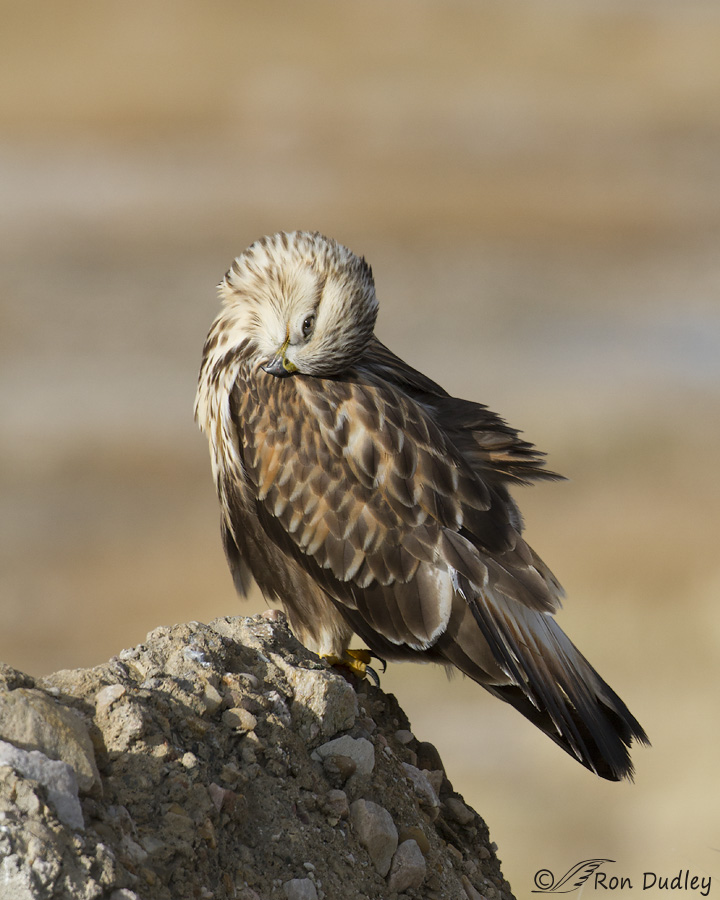
The Rough-legged Hawk featured in yesterday’s post did almost exactly the same thing. Sadly I deleted all the photos of it accessing its gland because at this angle I couldn’t actually see the gland and I couldn’t see the hawk’s face clearly while it was accessing the gland. Here some of the back feathers are still raised immediately after the bird had retrieved oil from the gland.
In this photo the hawk is smearing oil on its “shoulder” feathers.
While I was with the hawk it applied oil to feathers on several regions of its body but birds have a problem when it comes to applying oil to feathers on their head. They can’t reach the top and back of their head with their beak and they don’t have hands so how do they do it?
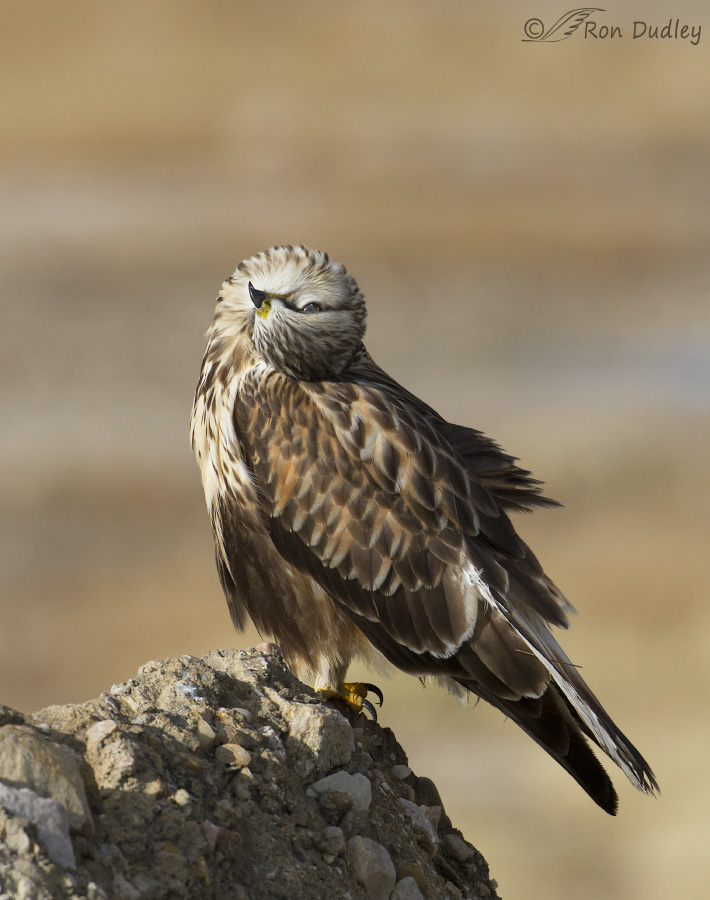
They’re pretty creative about it. They have very flexible necks so they simply rub their heads on other areas of their bodies that have been oiled previously and that transfers some of the oil to their head feathers.
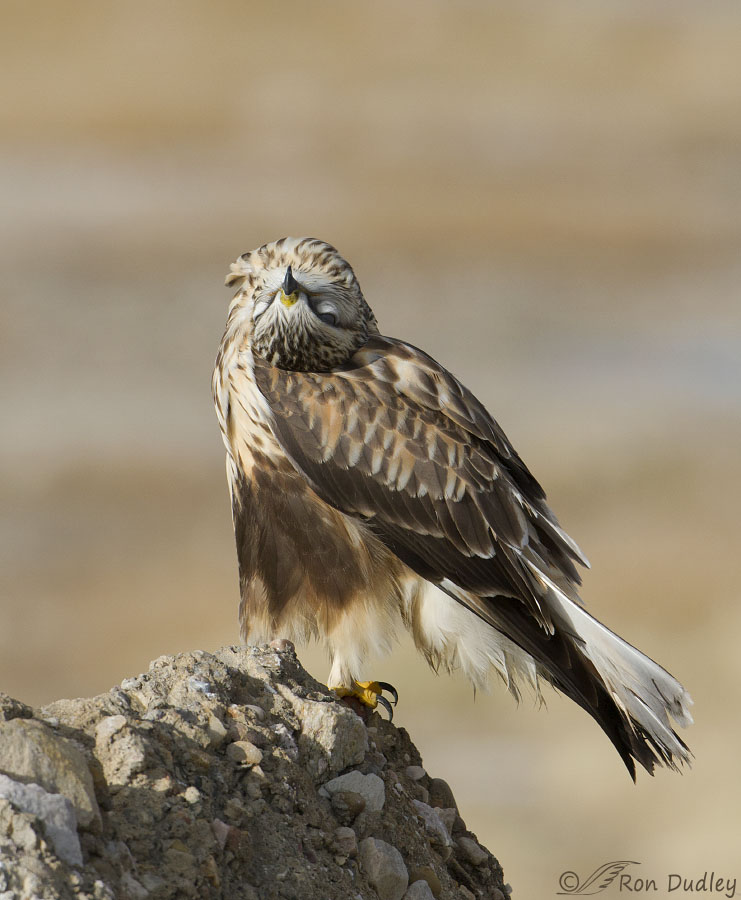
They’re even capable of getting the oil on the tops of their heads by twisting their necks and heads to extreme angles (seeing this posture makes my eyes water and I can almost hear my neck cracking…).
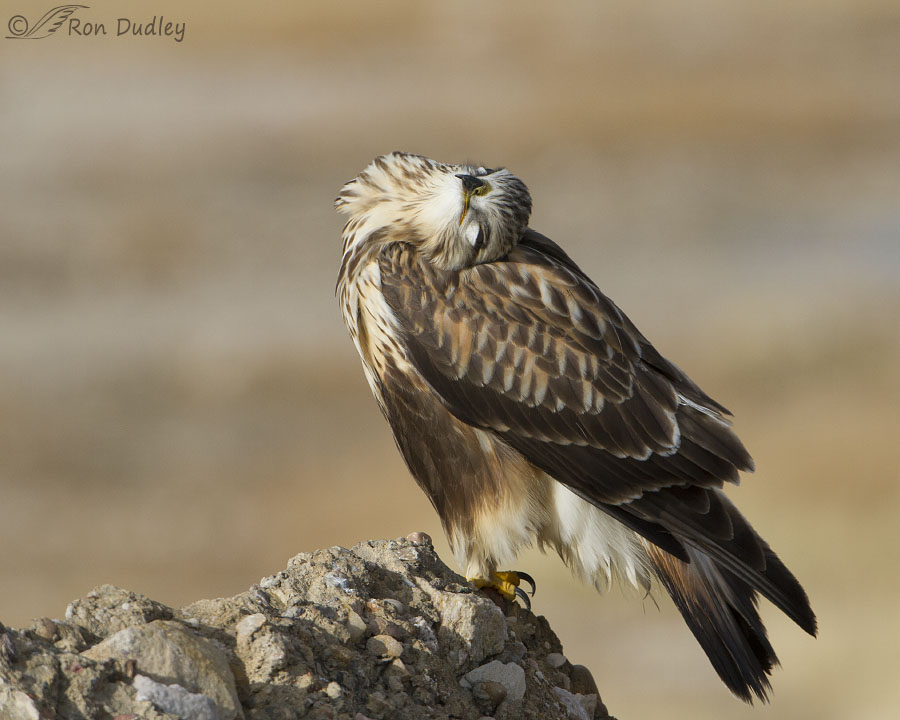
44 photos later the hawk repeated the entire process after retrieving more oil from the gland.
Birds are fastidious about preening and keeping their feathers in good shape. Their very lives depend on it.
Ron
PS – If you have the interest here’s an interesting video clip of a male Great Hornbill applying yellow oil from preen gland to its wings, neck and bill.


Wonderful series and info Ron!
Charlotte
Thanks for the detailed info and the wonderful photos!
You’re very welcome, Roberta.
Thank you for this informative post, Ron. As a kid my first pets were chickens, a Hen & Rooster given to me by a neighbour. My Mom grew up on a Chicken farm so was able to explain a bit about the oil gland at the base of the tail but not as good a lesson as what you have taught here today, including the pictures. Great post!
Thanks, Shirley.
Ron, I just see and learn something new every day from your posts. I really never knew much about the preening, cleaning the birds do. Very interesting. Thanks.
Thank you, Trudy.
The photos of the RLHA are fabulous, Ron! The one with his head upside down over his coverts is something I’ve never seen before. Thanks!
Thanks, too, to Laura Culley for her quotes from Hanson’s book. That is a great book.
Sallie, those seven extra vertabra come in handy, don’t they?
I thoroughly enjoyed Hanson’s book, but the oil/water resistance thing just shocked me! That said, I love it when our human assumptions are proven wrong and I’m delighted that we’re now looking into things scientifically instead of just making stuff up as we go…LOL! That said, admittedly it made common sense that the oil was responsible for water resistance. One of the few times when common sense failed
Good point, Laura. We have 7 cervical vertebrae while birds have anywhere from 13 – 25 cervical vertebrae – a huge advantage in neck flexibility.
I believe all raptors have 14. One of the swans, if memory serves, has 22 or 23. Isn’t it interesting how different genera have these skeletal differences? Not as common in mammals, I think. All mammals, including giraffes, have 7 vertebrae, yes, even in that long neck.
Yep Sallie, even giraffes have seven! I constantly marvel at bird adaptations. The whole vulture thing just delights my soul, but I could go on and on about birds. They just ROCK!
Sallie did you live in Texas several years ago?
Thanks, Sallie. I agree, the info Laura provided contributed a lot to the discussion.
What everyone else said, squared! Great words, great images, great lesson! Thank you.
Cheers
Dick
Thanks very much, Dick.
One of the things that SHOCKED me in the book, “Feathers: The Evolution of a Natural Miracle,” by Thor Hanson was that the oil does NOT contribute to the waterproofing/water resistance in their feathers! He (and other -ologists) proved that the water resistance has to do with the tension between the weight of the water versus the structure of the feather combined with air pockets trapped between touch points between the barbs.
On page 218, he writes, “Most feather researchers now agree that structure is the key to waterproofing. Their experiments have subjected feathers to cleaning by harsh detergents or ethyl alcohol, and they have come up with pressurized contraptions to force water and air through the plumes. In spite of such treatment, flight feathers and contour feathers demonstrated their resistance to water time and time again. Only down feathers appear to be soakable, and even those offer some level of water resistance. Mallard ducklings manage to keep dry within their natal down on regular swims just a few days after hatching, before their preen glands have even started producing oil.”
He continues on page 219, writing, “Just how they do it remains something of a mystery. I contacted a Chinese scientist whose team had studied the micro-roughness of plumes from twenty-nine different bird species. They calculated the number of ‘touch points,’ all the tiny edges and corners in the lattice of a feather vane that come into contact with water. Most birds have dozens of touch points in every square millimeter of feather surface, but that number increases dramatically for many water birds, up to an incredible nine hundred distinct points per millimeter in a Jackass Penguin feather. He told me it was the density of touch points that determined water resistance–all those distinct places pushing against the natural surface tension of the water. On the other hand, an Israeli physicist was adamant when he explained to me it was the air pockets trapped between touching points that actually repelled the water, not the points themselves. He had taken electron microscope images of a tiny water droplet perched atop a pigeon feather, with air pockets clearly visible between the feather barbs below. Increased density of barbs (and barbules and barbicels), he argued, would increase the number of air pockets and the degree of water resistance correspondingly.”
There’s more to this explanation, including photos, but that’s the crux of it. A little later he gets into the serious magic of diving birds like cormorants, writing on pages 220-221, “A cormorant contour feather is loose and wettable only around the periphery of the vane. Toward the rachis, the barbs become increasingly dense, with nearly as many touching points as a penguin feather.”
The other thing I found interesting is that (human) manufacturers like Gore-Tex have not yet been able to replicate the magic of feather structures in their cold weather/water resistant clothing/gear. In fact, they’re not even close!!
That’s fascinating stuff, Laura. I learned something! However I just can’t wrap my head around the claim that preen oil doesn’t at least contribute to some of the waterproofing. After all, by definition oils are hydrophobic ( literally “water-fearing” but what it means is water repellant) so how could oil on the feather not be at least part of the equation??? That’s a rhetorical question and I’m not disputing Hanson’s conclusion since it won’t be the first time that actual fact didn’t seem logical to me…
Yeah, I GET that Ron. It just makes common sense that the oils contribute to water resistance, but it seems that isn’t so. Like I said, I was shocked by that and I’m still trying to wrap MY brain around it! I’m still struggling with the concept of murmurations and thousands of hawks/falcons in a migrational kettle! I’m going to have to see those things to REALLY believe them! In the meantime, I’m filing all this stuff in the Magic Yowzer folder in my brain
Fascinating, Laura! Thanks for sharing this info!
You’re welcome Marty! That’s the biggest thing that stuck in my mind about that book. There are other little tidbits. But it all boils down to if this reincarnation thing is a thing, I want feathers the next time around–big, beautiful hawk/eagle feathers!! Otherwise, I ain’t coming back
These Images are very interesting…had an idea where that gland was but had never seen it…glad evil iPad was working…had problems with it yesterday….
Thanks, Patty.
The night heron shots are wonderful. And, that’s a remarkable adaptation. It reminds me of the way the platypus secretes milk from abdominal pores. Thinking about it, I can’t recall a mammal that oils its skin or feathers from its oil glands. Beaver castoreum doesn’t come from glands, per se, and the beaver doesn’t use it to oil itself, but to scent-mark territory. .something to chew on besides my toast..thanks!
Martha, Actually mammals do have glands that secrete oils/fats called sebaceous glands. They’re tiny and associated with individual hair follicles. They secrete a greasy mixture called sebum at the base of each hair. Sebum is referred to as a “polite fat” because it doesn’t turn rancid like most other fats. It serves as a dressing to keep the skin and hair pliable and glossy. Most mammals have sebaceous glands over their entire body but in humans they’re found mainly in the scalp and on the face.
Note: the primary difference between fats and oils is that fats are solid at room temperature and oils are liquids.
Those of us working around teenagers are well-versed in the “joys of sebum.”
Yup…
Wow! I didn’t know that, but now that you mention it, I get it. Interesting how they dry up with age, though–or at least they dried up in my dotage
Thanks, Teech! It is so much fun to be one of your students on this blog! Fabulous shots to illustrate your points too!
Fabulous shots to illustrate your points too!
I’m glad you liked it, Marty. Thanks.
Yeah for the professor! Excellent, educational, an exceptional lesson on avian preening!
Many thanks for sharing!
Thank you, Dick.
Outstanding photos and information. So often when photographing a raptor they will be in the midst of preening. Now reading this I have a better understanding of what they are doing. Thanks. Everett Sanborn, Prescott Arizona
Good! Happy to know I’ve contributed somewhat to your understanding of preening, Everett.
Thank you Ron! Very informative and excellently illustrated as usual!
Thank you, Gusset.
Your photos of the Night-heron show something I’ve never seen photographed at all before, let alone so clearly. Seems worthy of publication in an ornithology book.
“Seems worthy of publication in an ornithology book.”
Who knows, Nancy. Stranger things have happened. Thank you.
I love beautiful images as much as just about anybody around–and you provide them every day—but I look forward to your blog each morning for the wonderful information you provide
along with the beauty . The complexity of physiological adaptations in particular–like the preening gland –are just mind-boggling and truly wondrous to me . Thanks for including such
info on a regular basis !
I appreciate your comment about the info I provide, Kris. Sometimes I fear being perceived as a “know it all” but I learn a lot while researching this kind of post, probably more than many of my readers do. Some of them are much more knowledgeable than I am.
A most interesting and informative post today Ron! I’ve observed the preening process numerous times and found it fascinating to watch. I never knew about the oil gland though…now I understand the contortions and why they put their heads through the process. All this simply adds more to the wonders of nature. So much to learn and appreciate.
“I never knew about the oil gland though”
Good to know, Kathy. That’s exactly why I created this post.
Good job of describing the oil gland and what it’s used for particularly for those not aware of it/what it’s for. Birds preening DOES get very involved. Also wonderful photo’s of the night heron and rough-legged hawk
Thank you, Judy.